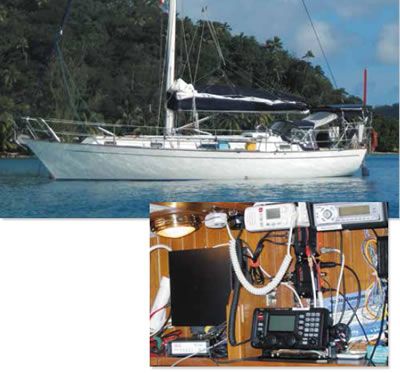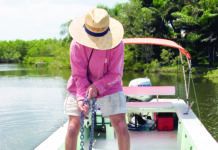This is in regard to the excellent November and December 2014 articles on SSB radios. I installed an Icom M802, KISS counterpoise, GAM backstay antenna, and Pactor Dragon modem for our Pacific crossing. Our boat is now on the hard in Fiji. We spent two years cruising in the Sea of Cortez prior to sailing to the Marquesas.
The M802 is easy to use, powerful, and has most of the features that a cruiser needs. Coupled with the Pactor Dragon modem, I can use a laptop to send and receive email, update our blog, and request and receive any and all weather and sea-state information thats available. In addition, we can communicate with virtually any Ham radio in the world via voice and can participate in the all-important cruisers nets throughout the Pacific. In my opinion, daily contact with other cruisers, especially during a crossing, is a dominant reason to go with SSB. The Icom M802 uses little current when its in standby or receive mode (the technology in SSBs suppresses the carrier and one sideband), so listening to other users or nets is not a strategy thats power-hungry.
Id like to point out that one needs not cut the backstay for a suitable antenna, but can use the GAM split-backstay antenna. Also, one need not trouble with 100 square feet of copper foil but can use the KISS counterpoise. I do not have a statistical control on my boat, of course, but I regularly communicate with SailMail and WinLink stations that are over 3,000 nautical miles from us. Our system worked well.
Photos courtesy of William Ennis

When I installed the SSB system, I needed to fully understand what I was doing and what supplies I needed to haul to Mexico for the installation. I depended on a fine book called Icom ICM802 Starting from Scratch. It details the installation techniques that I used, and even included a list of supplies that I would need and where each item should be installed, as well as a wonderful troubleshooting section. My experience was that the installation flowed much more smoothly with the book in hand, and I recommend it to anyone planning to install the radio. The books author, Commander Terry Sparks, has a series of books about the M802 and cruising in general. Weve depended on and used our M802 extensively while cruising.
My recommendation is that prospective users of an SSB budget for a Pactor Dragon modem as well, since it is the final hardware component for connecting 1950s radio technology to the modern world open to a laptop computer. Pactor compression is simply the only game in town, and the new P4 family of modems is extraordinary and communicates well with the M802. Airmail, as amazing as it is, is still free to everyone and most email services still use it. You mention in your article, and I concur, that acquiring your FCC General HF license will double the number of stations to which you can connect for email (and WinLink is free to Hams!), and increase the number of frequencies that are available for your use.
William Ennis
Wings, 1984 Passport 40
Alaska
I just ran into something that probably affects thousands of sailors: needing the correct respirator filters, particularly for two-part and bottom paints. It took me I would guess about 12 hours on the phone chasing the correct information, which I hasten to add no one seems to make easy to get to or clear once you do.
Long story short, after connecting with a tech at 3M, I learned there is a great deal of misinformation about which is the right filter to use when applying noxious paints. 3M now has a listing on the Web of filters, masks, and appropriate applications by chemical. I think this is vital for all to know. The Web address: http://multimedia.3m.com/mws/media/639110O/3m-respirator-selection-guide.pdf.
I just redid my dinghy with Interlux Perfection two-part and used 3Ms 6006 Multi Gas/Vapor Cartridge filter. It went from a dreaded, oozy-feeling, headache project to a joy, thanks to the right respirator filter.
Frank Thibodeau
Sceptre 41
Maine
One comment that should be included in the boom preventer discussion is that you need to be able to release it in a controlled manner if you do have an unintentional jibe. We used the vang to the toerail on my S2 -9.1 successfully for years. We had an accidental jibe going downwind with a chute in 22 knots over the deck. The spinnaker and the leeward toerail were in the water with the preventer holding the main in place to weather. There was too much tension on the vang to release it to free the main. My crew reached for his knife to cut it, but the boom broke at the vang before he could do it. In hindsight, this was probably for the better. If he had cut the vang, the boom would have gone up, and might have taken out the backstay as it crossed the boat. A better way would be to lead a line from a winch, through a block on the toerail, then to the boom, so you can let the boom down slowly in the event of an accidental jibe and subsequent knockdown.
John Brady
Director of PE Sailing,
Dartmouth College,
New Hampshire
In regard to your Nov. 26, 2014 blog on Florida Fish and Wildlifes public survey on anchoring rights in Florida: Extending adjacent private property owners control (ownership) over public waterways would be a dangerous abridgment of long-established legal precedents. They own only what they own. The public owns the waterways.
Safe anchoring is the boat owners concern covered by existing safety law. Forcing boats to hopscotch around on a timetable would be undue harassment. These issues are covered by existing responsibility rules. The waterways are not private streets or city streets; they are public domain.
Dall Wilson
Via Inside Practical Sailor
Anchoring should remain a freedom that all boaters can enjoy responsibly. If a boater is being a nuisance to a waterfront homeowner by being noisy or littering, the homeowner can and should notify authorities just as you would a troublesome land neighbor. There are already too many rules on the water, and anchoring should remain unrestricted.
Kevin Mulligan
Via Inside Practical Sailor
As a waterfront owner and sailor, I feel I have lived both sides of this issue. After being kept awake by all night parties at anchor in front of my house, Ive had to police the beach for empty bottles, garbage, and even soiled diapers; furthermore, I had to snorkel the shore line to remove broken glass bottles to protect kids from cut feet.
As a sailor, I understand the need for appropriate access to safe anchorages, but I don’t expect to be able to anchor anywhere I please. [The Nov. 26, 2014 blog] is big on sarcasm and lacking in balance. Property owners and boaters have rights. Its unfortunate that government is so inept (as is so often the case) at balancing the needs of both. Does commonsense get applied to legislation anymore?
Michael Serafini
Via Inside Practical Sailor
In your review of whipping twines in the December 2014 issue, you forgot to mention dental floss. I have used flat-ribbon dental floss for years to whip lines. It comes in a handy container, holds snuggly, and seem to resist UV and the marine environment very nicely. The ribbon variety lays flat and does not hurt the line.
C. Henry Depew
Sisu 26
Tallahassee, Fla.
Dental floss (usually nylon or polyester) is much weaker than the weakest twine we tested, and its not much cheaper than its twine equivalent. It will not last as long as the twines we tested. With all that said, we have used it for sewing canvas and whipping; as you point out, it works. It will do in a pinch, but the right twine is best for stitching splices and other critical jobs.
As a sailor who long coveted an Express 37, and who finally bought one four years ago, I really enjoyed your review of the Express 37 (see PS November 2014 online). However, the article seemingly referred to contemporary conversations with designer Carl Schumacher.
Fred Kaseburg
Champagne Express, Express 37
Seattle
The review was an updated and expanded version of an earlier test. We regret not clarifying that Schumacher had passed. Thanks for setting the record straight.





































